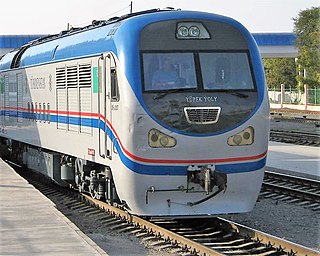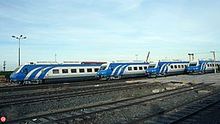Transport in Turkmenistan includes roadways, railways, airways, seaways, and waterways, as well as oil-, gas-, and water pipelines. Road-, rail-, and waterway transport fall under the jurisdiction of the Ministry of Industry and Communications.

Transport in Afghanistan is done mostly by road, rail and air. Much of the nation's road network was built in the mid-20th century but left to ruin during the last two decades of that century due to war and political turmoil. Officials of the current Islamic Emirate have continued to improve the national highways, roads, and bridges. In 2008, there were about 700,000 vehicles registered in Kabul. At least 1,314 traffic collisions were reported in 2022.

Iran has a long paved road system linking most of its towns and all of its cities. In 2011 the country had 173,000 kilometres (107,000 mi) of roads, of which 73% were paved. In 2008 there were nearly 100 passenger cars for every 1,000 inhabitants.
The Trans-Asian Railway(TAR) is a project to create an integrated freight railway network across Europe and Asia. The project is of the United Nations Economic and Social Commission for Asia and the Pacific (UNESCAP).

Pakistan Railways is the national, state-owned railway company of Pakistan with its headquarters in Lahore. Founded in 1861 as the North Western State Railway and headquartered in Lahore, it owns 7,789 kilometres of operational track across Pakistan, stretching from Peshawar to Karachi, offering both freight and passenger services, covering 488 operational stations across Pakistan.

The Trans-Iranian Railway was a major railway building project started in Pahlavi Iran in 1927 and completed in 1938, under the direction of the then-Iranian monarch Reza Shah. It was entirely built with indigenous capital, and links the capital Tehran with Bandar Shahpur on the Persian Gulf in the south and Bandar Shah on the Caspian Sea in the north, via Ahvaz and Ghom. In 1961, under Reza Shah's son Mohammad Reza Pahlavi, it was extended from Bandar Shah to a new terminus in Gorgan. During the land reforms of Mohammad Reza Pahlavi in 1963, as part of the "White Revolution", the Trans-Iranian railway was extended to link Tehran to Mashhad, Tabriz and Isfahan.
Qazaqstan Temır Joly is the national railway company of Kazakhstan.

Iran and Turkmenistan share a common border of more than 1000 km. Since Turkmenistan's independence from the Soviet Union in 1991, the two countries have enjoyed good relations and have cooperated in economic, transportation, infrastructure development, and energy sectors. The two nations have strong historic ties.

Afghanistan has three railway lines in the north of the country. The first is between Mazar-i-Sharif and the border town of Hairatan in Balkh province, which then connects with Uzbek Railways of Uzbekistan. The second links Torghundi in Herat province with Turkmen Railways of Turkmenistan. The third is between Turkmenistan and Aqina in Faryab province of Afghanistan, which extends south to the city of Andkhoy. The country currently lacks a passenger rail service, but a new rail link from Herat to Khaf in Iran for both cargo and passengers was recently completed. Passenger service is also proposed in Hairatan – Mazar-i-Sharif section and Mazar-i-Sharif – Aqina section.

Chabahar Port is a seaport in Chabahar located in southeastern Iran, on the Gulf of Oman. It serves as Iran's only oceanic port, and consists of two separate ports named Shahid Kalantari and Shahid Beheshti, each of which has five berths. It is only about 170 kilometres west of the Pakistani port of Gwadar.

Railway electrification in Iran describes the past and present electrification systems used to supply traction current to rail transport in Iran with a chronological record of development, a list of lines using each system, and a history and a technical description of each system.

Rail transport in Azerbaijan is operated by the national state-owned railway company Azerbaijan Railways. The railway network consists of 2,918 km (1,813 mi), its gauge is 1,520 mm, 815 km (506 mi) are double track and 1,272 km (790 mi) are electrified at 3 kV (3,000 V) DC.

The International North–South Transport Corridor (INSTC) is a 7,200-km long multi-mode network of ship, rail, and road route for moving freight between India, Iran, Azerbaijan, Russia, Central Asia and Europe. The route primarily involves moving freight from India, Iran, Azerbaijan and the Russian Federation via ship, rail and road. The objective of the corridor is to increase trade connectivity between major cities such as Mumbai, Moscow, Tehran, Baku, Bandar Abbas, Astrakhan, Bandar Anzali, etc. Dry runs of two routes were conducted in 2014, the first was Mumbai to Baku via Bandar Abbas and the second was Mumbai to Astrakhan via Bandar Abbas, Tehran and Bandar Anzali. The objective of the study was to identify and address key bottlenecks. The results showed transport costs were reduced by "$2,500 per 15 tons of cargo". Other routes under consideration include via Kazakhstan and Turkmenistan.

Azerbaijan Railways is the national state-owned rail transport operator in the Republic of Azerbaijan. The 2,918 km (1,813 mi), 1,520 mm gauge network is electrified at 3 kV (3,000 V) DC. The headquarters of the Azerbaijan Railways is in the capital Baku.

In the second half of the 19th century, during the time of Nasser-al-Din Shah, a short horse-driven suburban railway was established south of Tehran that was later converted to steam. This line was closed in 1952.

Turkmenistan has 4,980 kilometres (3,090 mi) of railways. The railway operator is the state owned company Türkmendemirýollary. The company belongs to the Ministry of Railways of Turkmenistan. Turkmenistan is currently expanding its rail system to cover 5,256.25 kilometres (3,266.08 mi) more distance, which will take its network to 10,236.25 kilometres (6,360.51 mi) track kilometres by 2025.

The Railways Agency of Turkmenistan (Turkmen: "Türkmendemirýollary" agentligi, previously the Ministry of Railways, is a government agency in Turkmenistan responsible for oversight of the state rail corporation "Demirýollary" AGPJ.

Zahedan Railway Station is located in Zahedan, Iran. It serves as the terminus for the Quetta–Taftan Railway Line and Bam-Zahedan railway. It also serves as the break of gauge between Pakistan Railways 1,676 mm broad gauge and Islamic Republic of Iran Railways 1,435 mmstandard gauge. It is one of the three stations in Iran which are served by Pakistan Railways.
The Five Nations Railway Corridor or Five States Railway Corridor is a proposed rail link in Central Asia between Iran in the west, through Afghanistan, Tajikistan, Kyrgyzstan, and reaching China in the east. Around half of the length of the railway would pass through northern Afghanistan. A preliminary agreement for developing the FNRC project was signed in the Tajik capital Dushanbe in December 2014 and has moved sluggishly since then. The project with a length of 2100 kilometres will run through five countries- China, Tajikistan, Kyrgyzstan, Afghanistan, and Iran, connecting China with the Iranian ports of Chabahar and Bandar Abbas. About 50 percent of the total railway line, roughly 1148 kilometres, will cross through Afghanistan's Kunduz, Balkh, Jawozjan, Faryab, Badghis, and Herat provinces. A preliminary agreement for the railway link was first signed in 2014, with costs estimated at US$2 billion, however construction of the main section through Afghanistan is uncertain due to the ongoing conflict in Afghanistan.
The Chabahar–Zahedan railway is a railway line currently under construction in Iran.


























